DET Level 5 Assignment: Working with Individual Learners Analysis
VerifiedAdded on 2023/06/08
|10
|2463
|96
Report
AI Summary
This report delves into the multifaceted aspects of working with individual learners, examining the distinct roles and responsibilities of coaches, teachers, and mentors, and highlighting the differences between mentoring, coaching, and teaching roles in meeting individual learning needs. It justifies the selection of various strategies to cater to diverse learner requirements, exemplified through case studies involving students with dyslexia, behavioral issues, and varying academic capabilities. The report further reviews the resources necessary for an effective multi-agency approach, emphasizing the benefits of collaborative partnerships in educational settings. The processes involved in one-to-one coaching, teaching, and mentoring are analyzed in relation to their intellectual, emotional, and social benefits, and the report concludes with a reflection on the author's own teaching practice, identifying strengths and areas for improvement in addressing the unique challenges faced by individual learners. Desklib offers a variety of resources to aid students in similar studies.

Running head: WORKING WITH INDIVIDUAL LEARNERS
Working with individual learners
Name of the student
University name
Author’s note
Working with individual learners
Name of the student
University name
Author’s note
Paraphrase This Document
Need a fresh take? Get an instant paraphrase of this document with our AI Paraphraser
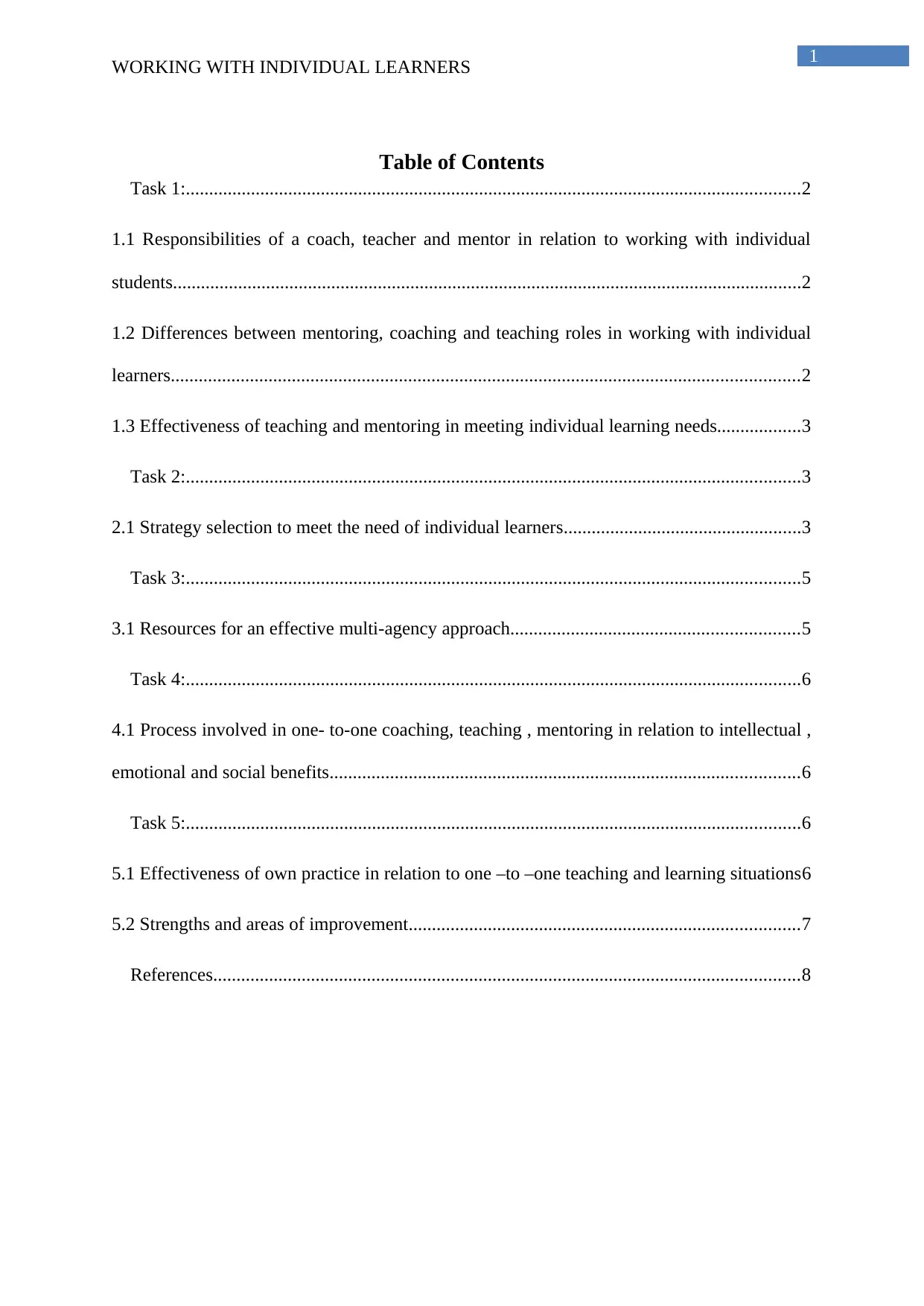
1
WORKING WITH INDIVIDUAL LEARNERS
Table of Contents
Task 1:....................................................................................................................................2
1.1 Responsibilities of a coach, teacher and mentor in relation to working with individual
students.......................................................................................................................................2
1.2 Differences between mentoring, coaching and teaching roles in working with individual
learners.......................................................................................................................................2
1.3 Effectiveness of teaching and mentoring in meeting individual learning needs..................3
Task 2:....................................................................................................................................3
2.1 Strategy selection to meet the need of individual learners...................................................3
Task 3:....................................................................................................................................5
3.1 Resources for an effective multi-agency approach..............................................................5
Task 4:....................................................................................................................................6
4.1 Process involved in one- to-one coaching, teaching , mentoring in relation to intellectual ,
emotional and social benefits.....................................................................................................6
Task 5:....................................................................................................................................6
5.1 Effectiveness of own practice in relation to one –to –one teaching and learning situations6
5.2 Strengths and areas of improvement....................................................................................7
References..............................................................................................................................8
WORKING WITH INDIVIDUAL LEARNERS
Table of Contents
Task 1:....................................................................................................................................2
1.1 Responsibilities of a coach, teacher and mentor in relation to working with individual
students.......................................................................................................................................2
1.2 Differences between mentoring, coaching and teaching roles in working with individual
learners.......................................................................................................................................2
1.3 Effectiveness of teaching and mentoring in meeting individual learning needs..................3
Task 2:....................................................................................................................................3
2.1 Strategy selection to meet the need of individual learners...................................................3
Task 3:....................................................................................................................................5
3.1 Resources for an effective multi-agency approach..............................................................5
Task 4:....................................................................................................................................6
4.1 Process involved in one- to-one coaching, teaching , mentoring in relation to intellectual ,
emotional and social benefits.....................................................................................................6
Task 5:....................................................................................................................................6
5.1 Effectiveness of own practice in relation to one –to –one teaching and learning situations6
5.2 Strengths and areas of improvement....................................................................................7
References..............................................................................................................................8
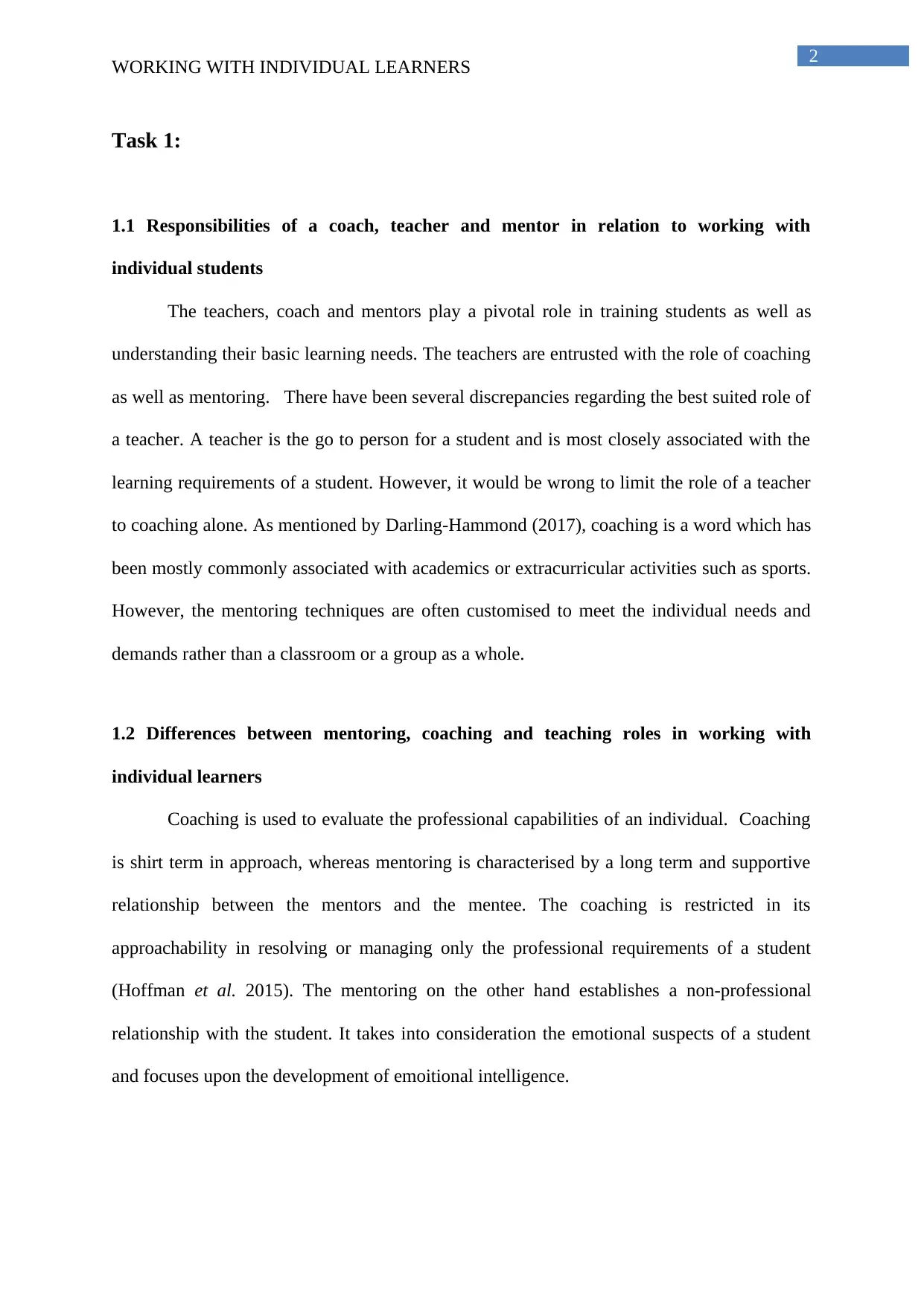
2
WORKING WITH INDIVIDUAL LEARNERS
Task 1:
1.1 Responsibilities of a coach, teacher and mentor in relation to working with
individual students
The teachers, coach and mentors play a pivotal role in training students as well as
understanding their basic learning needs. The teachers are entrusted with the role of coaching
as well as mentoring. There have been several discrepancies regarding the best suited role of
a teacher. A teacher is the go to person for a student and is most closely associated with the
learning requirements of a student. However, it would be wrong to limit the role of a teacher
to coaching alone. As mentioned by Darling-Hammond (2017), coaching is a word which has
been mostly commonly associated with academics or extracurricular activities such as sports.
However, the mentoring techniques are often customised to meet the individual needs and
demands rather than a classroom or a group as a whole.
1.2 Differences between mentoring, coaching and teaching roles in working with
individual learners
Coaching is used to evaluate the professional capabilities of an individual. Coaching
is shirt term in approach, whereas mentoring is characterised by a long term and supportive
relationship between the mentors and the mentee. The coaching is restricted in its
approachability in resolving or managing only the professional requirements of a student
(Hoffman et al. 2015). The mentoring on the other hand establishes a non-professional
relationship with the student. It takes into consideration the emotional suspects of a student
and focuses upon the development of emoitional intelligence.
WORKING WITH INDIVIDUAL LEARNERS
Task 1:
1.1 Responsibilities of a coach, teacher and mentor in relation to working with
individual students
The teachers, coach and mentors play a pivotal role in training students as well as
understanding their basic learning needs. The teachers are entrusted with the role of coaching
as well as mentoring. There have been several discrepancies regarding the best suited role of
a teacher. A teacher is the go to person for a student and is most closely associated with the
learning requirements of a student. However, it would be wrong to limit the role of a teacher
to coaching alone. As mentioned by Darling-Hammond (2017), coaching is a word which has
been mostly commonly associated with academics or extracurricular activities such as sports.
However, the mentoring techniques are often customised to meet the individual needs and
demands rather than a classroom or a group as a whole.
1.2 Differences between mentoring, coaching and teaching roles in working with
individual learners
Coaching is used to evaluate the professional capabilities of an individual. Coaching
is shirt term in approach, whereas mentoring is characterised by a long term and supportive
relationship between the mentors and the mentee. The coaching is restricted in its
approachability in resolving or managing only the professional requirements of a student
(Hoffman et al. 2015). The mentoring on the other hand establishes a non-professional
relationship with the student. It takes into consideration the emotional suspects of a student
and focuses upon the development of emoitional intelligence.
⊘ This is a preview!⊘
Do you want full access?
Subscribe today to unlock all pages.

Trusted by 1+ million students worldwide
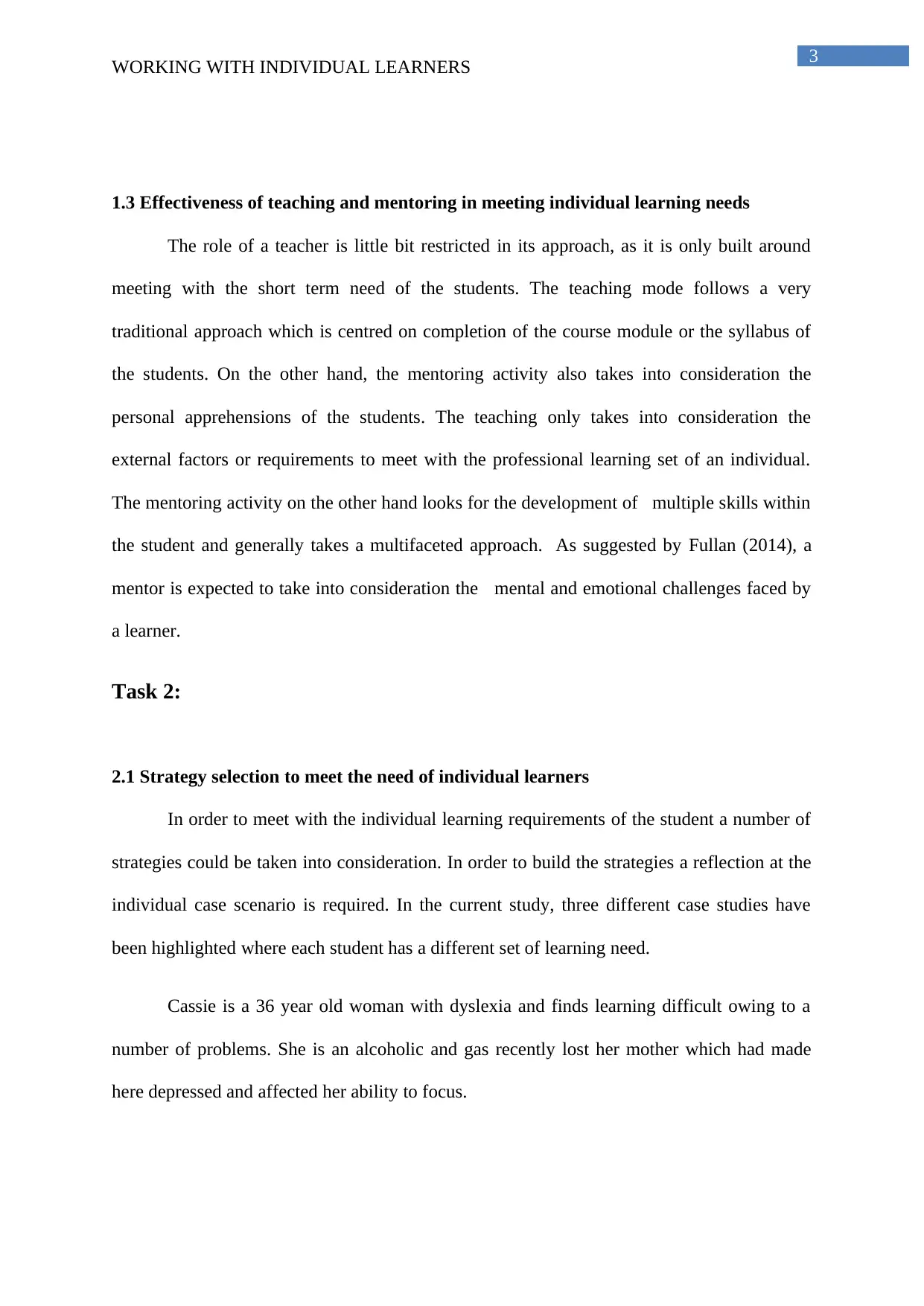
3
WORKING WITH INDIVIDUAL LEARNERS
1.3 Effectiveness of teaching and mentoring in meeting individual learning needs
The role of a teacher is little bit restricted in its approach, as it is only built around
meeting with the short term need of the students. The teaching mode follows a very
traditional approach which is centred on completion of the course module or the syllabus of
the students. On the other hand, the mentoring activity also takes into consideration the
personal apprehensions of the students. The teaching only takes into consideration the
external factors or requirements to meet with the professional learning set of an individual.
The mentoring activity on the other hand looks for the development of multiple skills within
the student and generally takes a multifaceted approach. As suggested by Fullan (2014), a
mentor is expected to take into consideration the mental and emotional challenges faced by
a learner.
Task 2:
2.1 Strategy selection to meet the need of individual learners
In order to meet with the individual learning requirements of the student a number of
strategies could be taken into consideration. In order to build the strategies a reflection at the
individual case scenario is required. In the current study, three different case studies have
been highlighted where each student has a different set of learning need.
Cassie is a 36 year old woman with dyslexia and finds learning difficult owing to a
number of problems. She is an alcoholic and gas recently lost her mother which had made
here depressed and affected her ability to focus.
WORKING WITH INDIVIDUAL LEARNERS
1.3 Effectiveness of teaching and mentoring in meeting individual learning needs
The role of a teacher is little bit restricted in its approach, as it is only built around
meeting with the short term need of the students. The teaching mode follows a very
traditional approach which is centred on completion of the course module or the syllabus of
the students. On the other hand, the mentoring activity also takes into consideration the
personal apprehensions of the students. The teaching only takes into consideration the
external factors or requirements to meet with the professional learning set of an individual.
The mentoring activity on the other hand looks for the development of multiple skills within
the student and generally takes a multifaceted approach. As suggested by Fullan (2014), a
mentor is expected to take into consideration the mental and emotional challenges faced by
a learner.
Task 2:
2.1 Strategy selection to meet the need of individual learners
In order to meet with the individual learning requirements of the student a number of
strategies could be taken into consideration. In order to build the strategies a reflection at the
individual case scenario is required. In the current study, three different case studies have
been highlighted where each student has a different set of learning need.
Cassie is a 36 year old woman with dyslexia and finds learning difficult owing to a
number of problems. She is an alcoholic and gas recently lost her mother which had made
here depressed and affected her ability to focus.
Paraphrase This Document
Need a fresh take? Get an instant paraphrase of this document with our AI Paraphraser
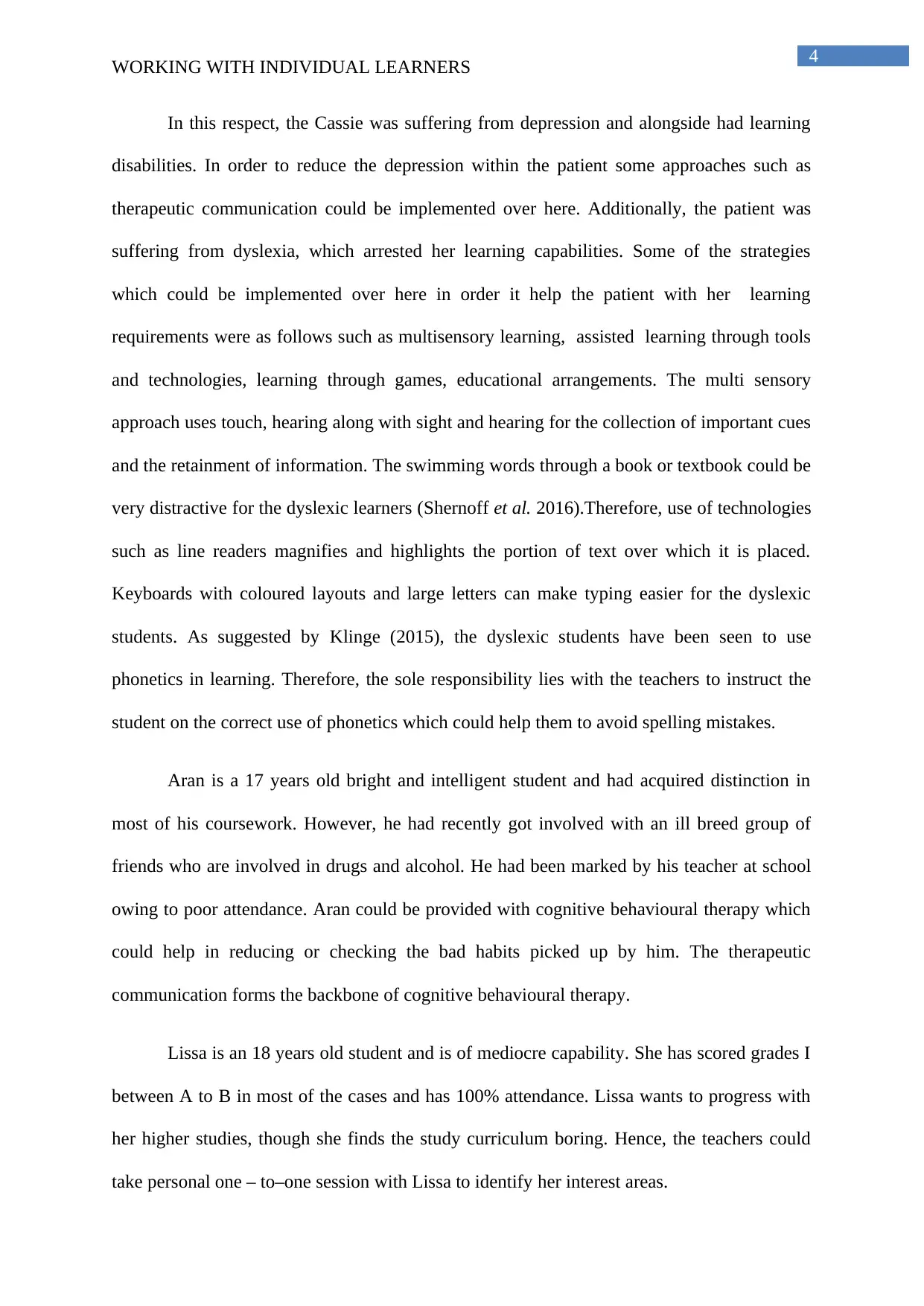
4
WORKING WITH INDIVIDUAL LEARNERS
In this respect, the Cassie was suffering from depression and alongside had learning
disabilities. In order to reduce the depression within the patient some approaches such as
therapeutic communication could be implemented over here. Additionally, the patient was
suffering from dyslexia, which arrested her learning capabilities. Some of the strategies
which could be implemented over here in order it help the patient with her learning
requirements were as follows such as multisensory learning, assisted learning through tools
and technologies, learning through games, educational arrangements. The multi sensory
approach uses touch, hearing along with sight and hearing for the collection of important cues
and the retainment of information. The swimming words through a book or textbook could be
very distractive for the dyslexic learners (Shernoff et al. 2016).Therefore, use of technologies
such as line readers magnifies and highlights the portion of text over which it is placed.
Keyboards with coloured layouts and large letters can make typing easier for the dyslexic
students. As suggested by Klinge (2015), the dyslexic students have been seen to use
phonetics in learning. Therefore, the sole responsibility lies with the teachers to instruct the
student on the correct use of phonetics which could help them to avoid spelling mistakes.
Aran is a 17 years old bright and intelligent student and had acquired distinction in
most of his coursework. However, he had recently got involved with an ill breed group of
friends who are involved in drugs and alcohol. He had been marked by his teacher at school
owing to poor attendance. Aran could be provided with cognitive behavioural therapy which
could help in reducing or checking the bad habits picked up by him. The therapeutic
communication forms the backbone of cognitive behavioural therapy.
Lissa is an 18 years old student and is of mediocre capability. She has scored grades I
between A to B in most of the cases and has 100% attendance. Lissa wants to progress with
her higher studies, though she finds the study curriculum boring. Hence, the teachers could
take personal one – to–one session with Lissa to identify her interest areas.
WORKING WITH INDIVIDUAL LEARNERS
In this respect, the Cassie was suffering from depression and alongside had learning
disabilities. In order to reduce the depression within the patient some approaches such as
therapeutic communication could be implemented over here. Additionally, the patient was
suffering from dyslexia, which arrested her learning capabilities. Some of the strategies
which could be implemented over here in order it help the patient with her learning
requirements were as follows such as multisensory learning, assisted learning through tools
and technologies, learning through games, educational arrangements. The multi sensory
approach uses touch, hearing along with sight and hearing for the collection of important cues
and the retainment of information. The swimming words through a book or textbook could be
very distractive for the dyslexic learners (Shernoff et al. 2016).Therefore, use of technologies
such as line readers magnifies and highlights the portion of text over which it is placed.
Keyboards with coloured layouts and large letters can make typing easier for the dyslexic
students. As suggested by Klinge (2015), the dyslexic students have been seen to use
phonetics in learning. Therefore, the sole responsibility lies with the teachers to instruct the
student on the correct use of phonetics which could help them to avoid spelling mistakes.
Aran is a 17 years old bright and intelligent student and had acquired distinction in
most of his coursework. However, he had recently got involved with an ill breed group of
friends who are involved in drugs and alcohol. He had been marked by his teacher at school
owing to poor attendance. Aran could be provided with cognitive behavioural therapy which
could help in reducing or checking the bad habits picked up by him. The therapeutic
communication forms the backbone of cognitive behavioural therapy.
Lissa is an 18 years old student and is of mediocre capability. She has scored grades I
between A to B in most of the cases and has 100% attendance. Lissa wants to progress with
her higher studies, though she finds the study curriculum boring. Hence, the teachers could
take personal one – to–one session with Lissa to identify her interest areas.
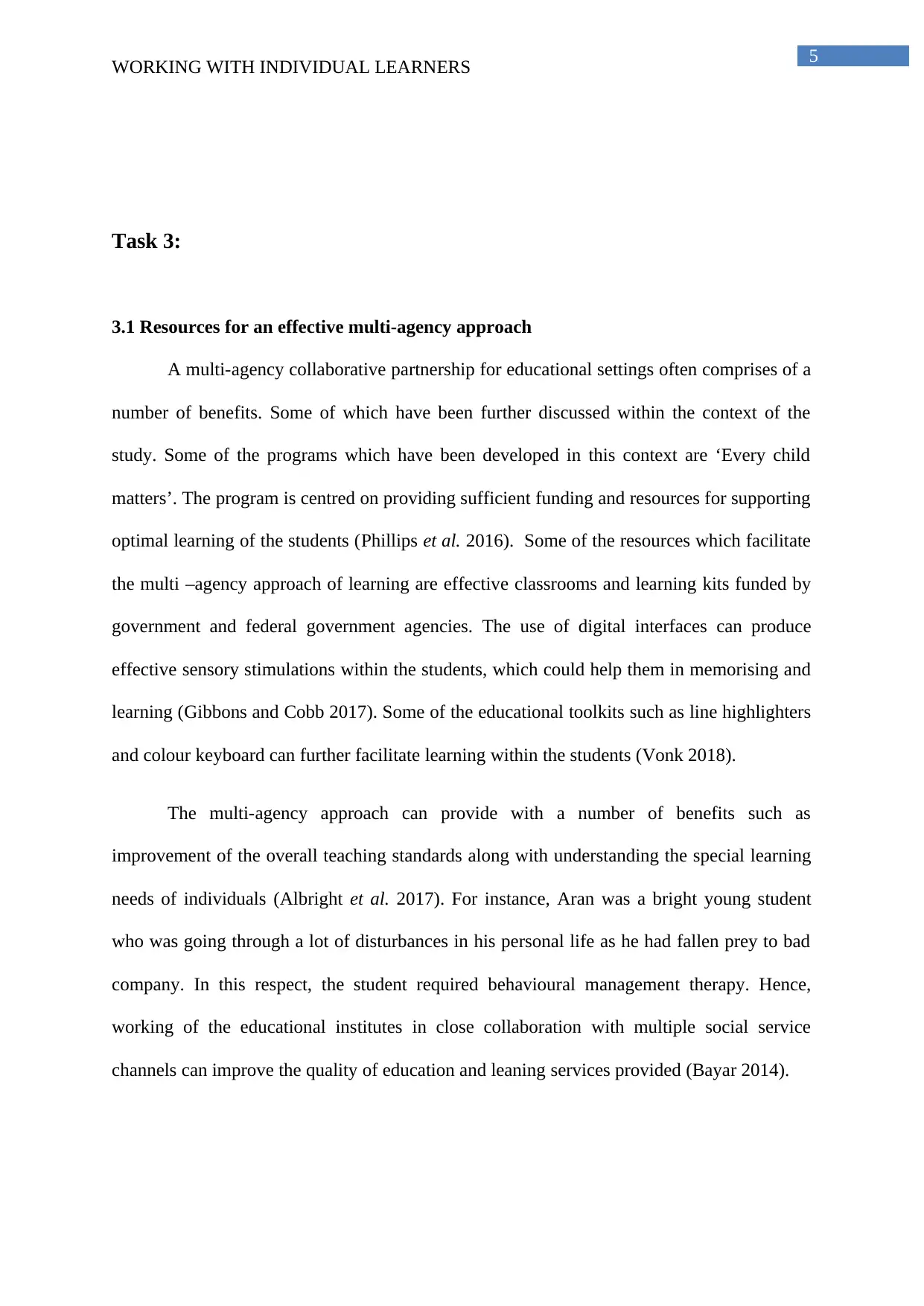
5
WORKING WITH INDIVIDUAL LEARNERS
Task 3:
3.1 Resources for an effective multi-agency approach
A multi-agency collaborative partnership for educational settings often comprises of a
number of benefits. Some of which have been further discussed within the context of the
study. Some of the programs which have been developed in this context are ‘Every child
matters’. The program is centred on providing sufficient funding and resources for supporting
optimal learning of the students (Phillips et al. 2016). Some of the resources which facilitate
the multi –agency approach of learning are effective classrooms and learning kits funded by
government and federal government agencies. The use of digital interfaces can produce
effective sensory stimulations within the students, which could help them in memorising and
learning (Gibbons and Cobb 2017). Some of the educational toolkits such as line highlighters
and colour keyboard can further facilitate learning within the students (Vonk 2018).
The multi-agency approach can provide with a number of benefits such as
improvement of the overall teaching standards along with understanding the special learning
needs of individuals (Albright et al. 2017). For instance, Aran was a bright young student
who was going through a lot of disturbances in his personal life as he had fallen prey to bad
company. In this respect, the student required behavioural management therapy. Hence,
working of the educational institutes in close collaboration with multiple social service
channels can improve the quality of education and leaning services provided (Bayar 2014).
WORKING WITH INDIVIDUAL LEARNERS
Task 3:
3.1 Resources for an effective multi-agency approach
A multi-agency collaborative partnership for educational settings often comprises of a
number of benefits. Some of which have been further discussed within the context of the
study. Some of the programs which have been developed in this context are ‘Every child
matters’. The program is centred on providing sufficient funding and resources for supporting
optimal learning of the students (Phillips et al. 2016). Some of the resources which facilitate
the multi –agency approach of learning are effective classrooms and learning kits funded by
government and federal government agencies. The use of digital interfaces can produce
effective sensory stimulations within the students, which could help them in memorising and
learning (Gibbons and Cobb 2017). Some of the educational toolkits such as line highlighters
and colour keyboard can further facilitate learning within the students (Vonk 2018).
The multi-agency approach can provide with a number of benefits such as
improvement of the overall teaching standards along with understanding the special learning
needs of individuals (Albright et al. 2017). For instance, Aran was a bright young student
who was going through a lot of disturbances in his personal life as he had fallen prey to bad
company. In this respect, the student required behavioural management therapy. Hence,
working of the educational institutes in close collaboration with multiple social service
channels can improve the quality of education and leaning services provided (Bayar 2014).
⊘ This is a preview!⊘
Do you want full access?
Subscribe today to unlock all pages.

Trusted by 1+ million students worldwide
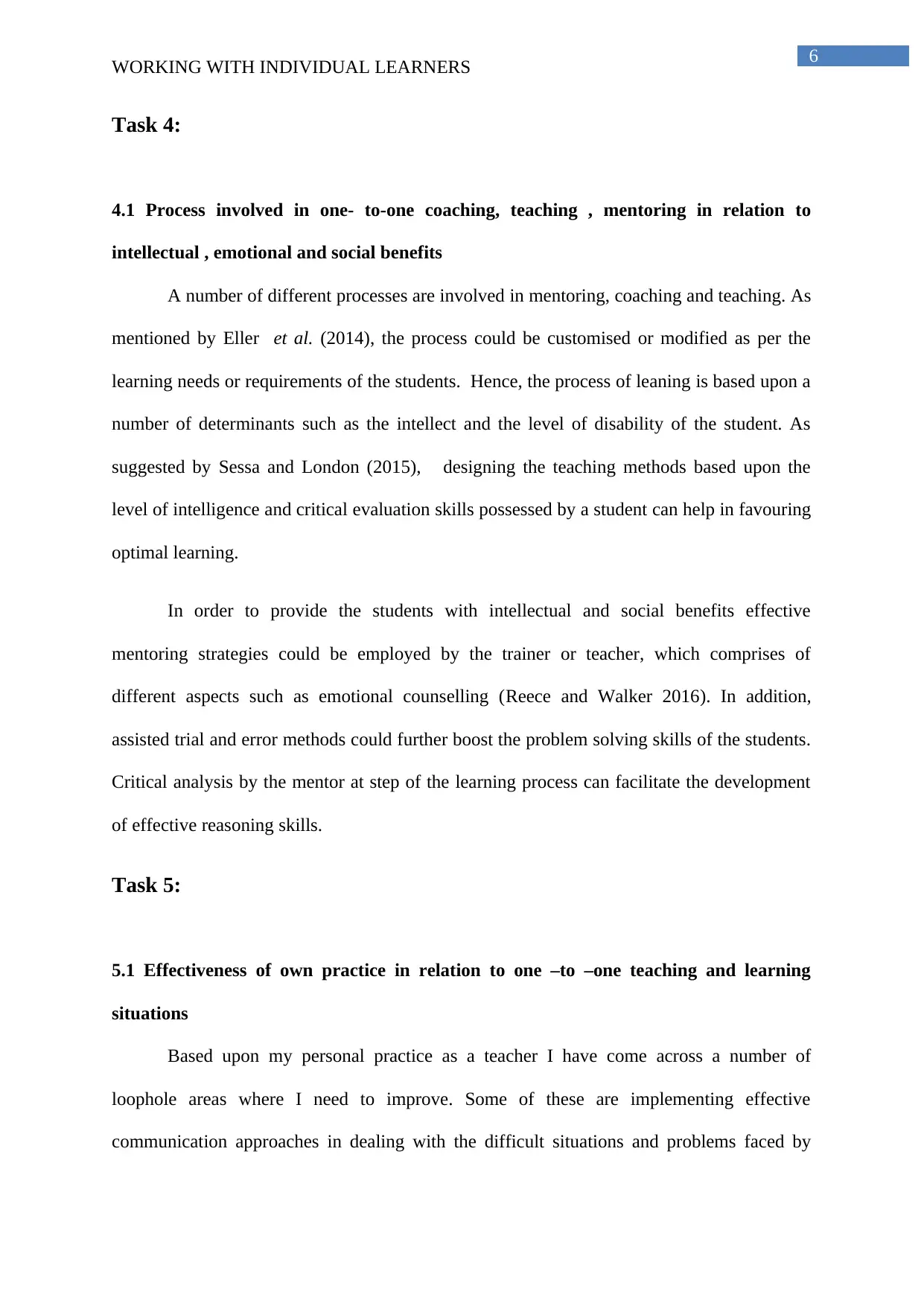
6
WORKING WITH INDIVIDUAL LEARNERS
Task 4:
4.1 Process involved in one- to-one coaching, teaching , mentoring in relation to
intellectual , emotional and social benefits
A number of different processes are involved in mentoring, coaching and teaching. As
mentioned by Eller et al. (2014), the process could be customised or modified as per the
learning needs or requirements of the students. Hence, the process of leaning is based upon a
number of determinants such as the intellect and the level of disability of the student. As
suggested by Sessa and London (2015), designing the teaching methods based upon the
level of intelligence and critical evaluation skills possessed by a student can help in favouring
optimal learning.
In order to provide the students with intellectual and social benefits effective
mentoring strategies could be employed by the trainer or teacher, which comprises of
different aspects such as emotional counselling (Reece and Walker 2016). In addition,
assisted trial and error methods could further boost the problem solving skills of the students.
Critical analysis by the mentor at step of the learning process can facilitate the development
of effective reasoning skills.
Task 5:
5.1 Effectiveness of own practice in relation to one –to –one teaching and learning
situations
Based upon my personal practice as a teacher I have come across a number of
loophole areas where I need to improve. Some of these are implementing effective
communication approaches in dealing with the difficult situations and problems faced by
WORKING WITH INDIVIDUAL LEARNERS
Task 4:
4.1 Process involved in one- to-one coaching, teaching , mentoring in relation to
intellectual , emotional and social benefits
A number of different processes are involved in mentoring, coaching and teaching. As
mentioned by Eller et al. (2014), the process could be customised or modified as per the
learning needs or requirements of the students. Hence, the process of leaning is based upon a
number of determinants such as the intellect and the level of disability of the student. As
suggested by Sessa and London (2015), designing the teaching methods based upon the
level of intelligence and critical evaluation skills possessed by a student can help in favouring
optimal learning.
In order to provide the students with intellectual and social benefits effective
mentoring strategies could be employed by the trainer or teacher, which comprises of
different aspects such as emotional counselling (Reece and Walker 2016). In addition,
assisted trial and error methods could further boost the problem solving skills of the students.
Critical analysis by the mentor at step of the learning process can facilitate the development
of effective reasoning skills.
Task 5:
5.1 Effectiveness of own practice in relation to one –to –one teaching and learning
situations
Based upon my personal practice as a teacher I have come across a number of
loophole areas where I need to improve. Some of these are implementing effective
communication approaches in dealing with the difficult situations and problems faced by
Paraphrase This Document
Need a fresh take? Get an instant paraphrase of this document with our AI Paraphraser
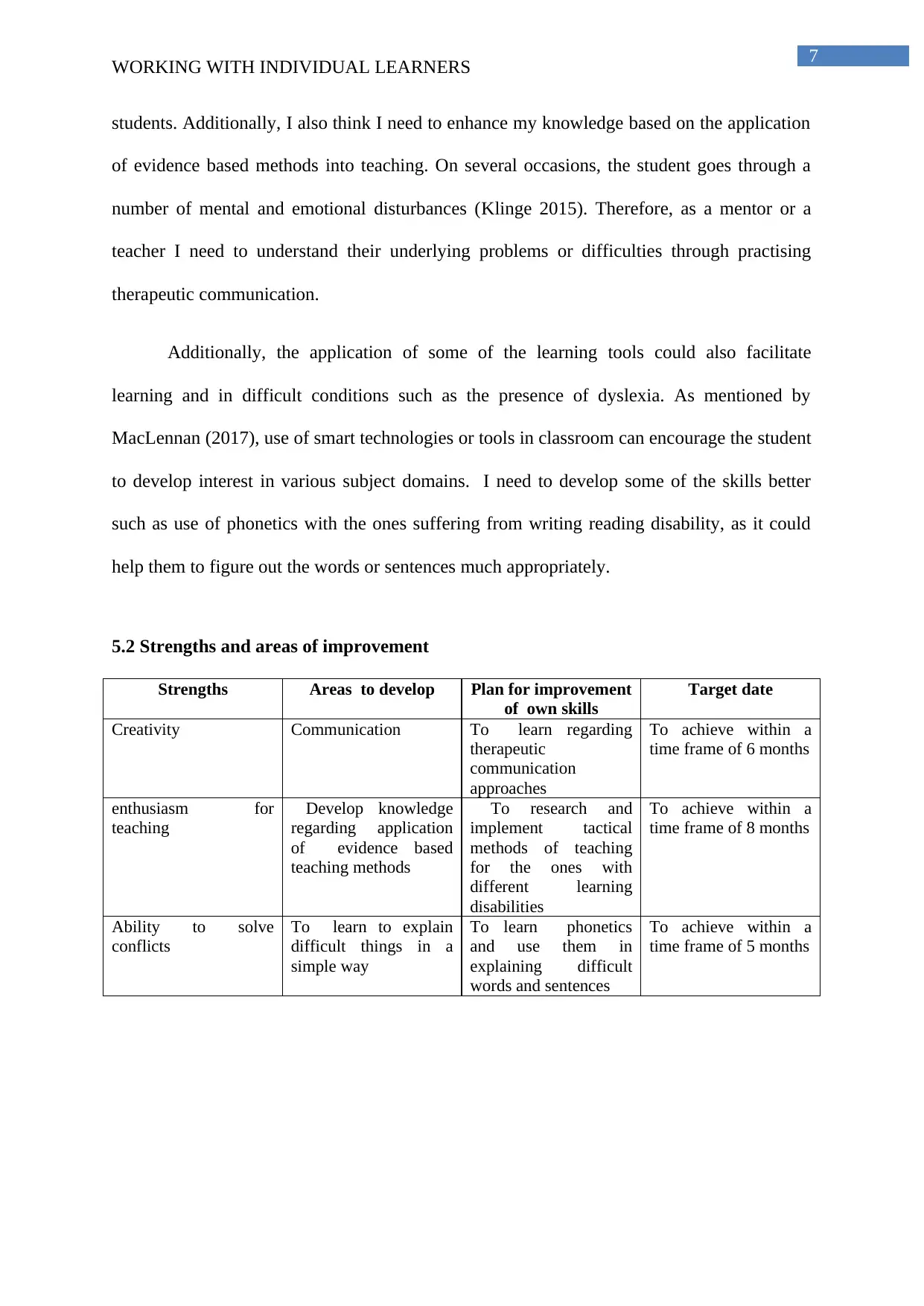
7
WORKING WITH INDIVIDUAL LEARNERS
students. Additionally, I also think I need to enhance my knowledge based on the application
of evidence based methods into teaching. On several occasions, the student goes through a
number of mental and emotional disturbances (Klinge 2015). Therefore, as a mentor or a
teacher I need to understand their underlying problems or difficulties through practising
therapeutic communication.
Additionally, the application of some of the learning tools could also facilitate
learning and in difficult conditions such as the presence of dyslexia. As mentioned by
MacLennan (2017), use of smart technologies or tools in classroom can encourage the student
to develop interest in various subject domains. I need to develop some of the skills better
such as use of phonetics with the ones suffering from writing reading disability, as it could
help them to figure out the words or sentences much appropriately.
5.2 Strengths and areas of improvement
Strengths Areas to develop Plan for improvement
of own skills
Target date
Creativity Communication To learn regarding
therapeutic
communication
approaches
To achieve within a
time frame of 6 months
enthusiasm for
teaching
Develop knowledge
regarding application
of evidence based
teaching methods
To research and
implement tactical
methods of teaching
for the ones with
different learning
disabilities
To achieve within a
time frame of 8 months
Ability to solve
conflicts
To learn to explain
difficult things in a
simple way
To learn phonetics
and use them in
explaining difficult
words and sentences
To achieve within a
time frame of 5 months
WORKING WITH INDIVIDUAL LEARNERS
students. Additionally, I also think I need to enhance my knowledge based on the application
of evidence based methods into teaching. On several occasions, the student goes through a
number of mental and emotional disturbances (Klinge 2015). Therefore, as a mentor or a
teacher I need to understand their underlying problems or difficulties through practising
therapeutic communication.
Additionally, the application of some of the learning tools could also facilitate
learning and in difficult conditions such as the presence of dyslexia. As mentioned by
MacLennan (2017), use of smart technologies or tools in classroom can encourage the student
to develop interest in various subject domains. I need to develop some of the skills better
such as use of phonetics with the ones suffering from writing reading disability, as it could
help them to figure out the words or sentences much appropriately.
5.2 Strengths and areas of improvement
Strengths Areas to develop Plan for improvement
of own skills
Target date
Creativity Communication To learn regarding
therapeutic
communication
approaches
To achieve within a
time frame of 6 months
enthusiasm for
teaching
Develop knowledge
regarding application
of evidence based
teaching methods
To research and
implement tactical
methods of teaching
for the ones with
different learning
disabilities
To achieve within a
time frame of 8 months
Ability to solve
conflicts
To learn to explain
difficult things in a
simple way
To learn phonetics
and use them in
explaining difficult
words and sentences
To achieve within a
time frame of 5 months
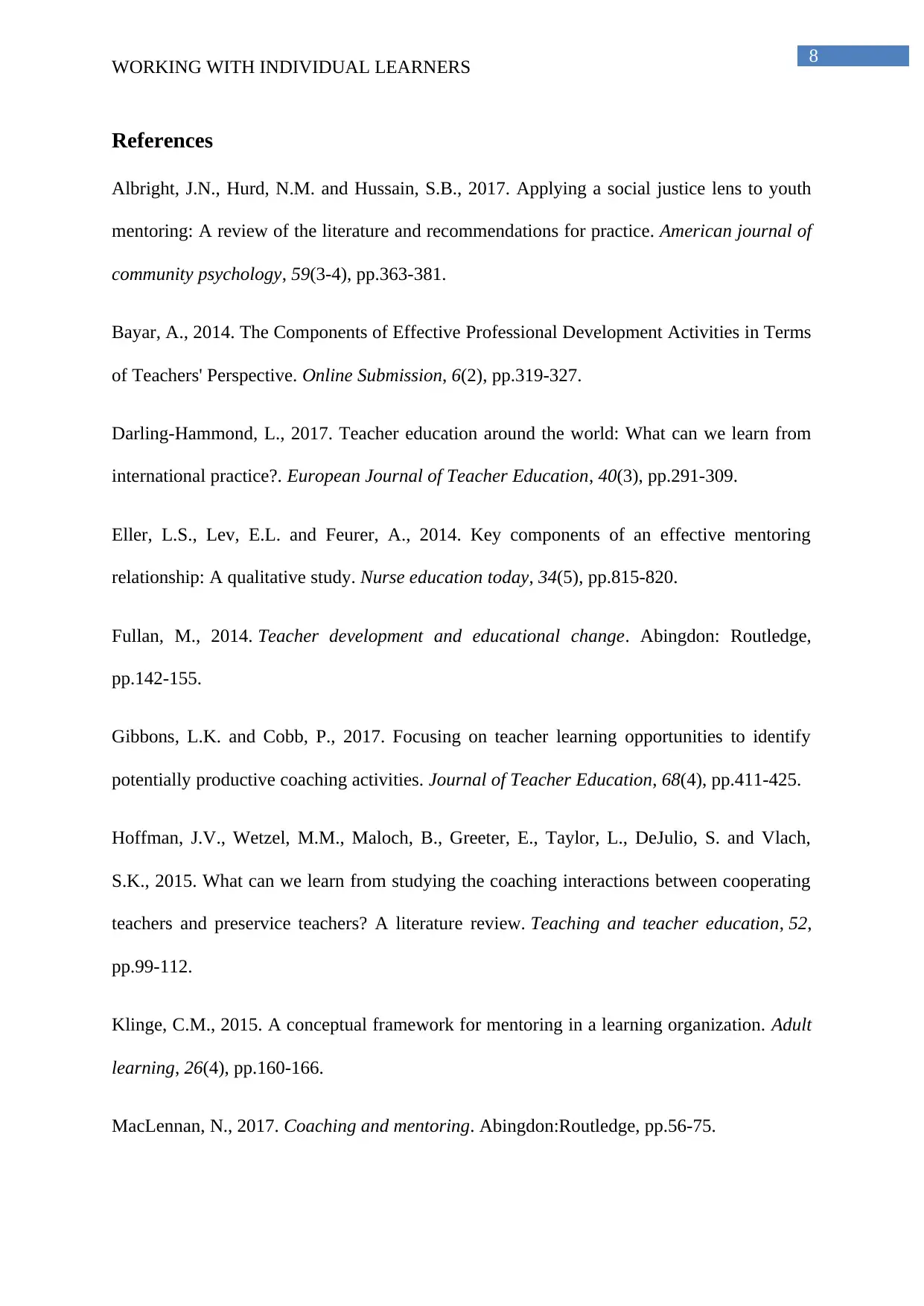
8
WORKING WITH INDIVIDUAL LEARNERS
References
Albright, J.N., Hurd, N.M. and Hussain, S.B., 2017. Applying a social justice lens to youth
mentoring: A review of the literature and recommendations for practice. American journal of
community psychology, 59(3-4), pp.363-381.
Bayar, A., 2014. The Components of Effective Professional Development Activities in Terms
of Teachers' Perspective. Online Submission, 6(2), pp.319-327.
Darling-Hammond, L., 2017. Teacher education around the world: What can we learn from
international practice?. European Journal of Teacher Education, 40(3), pp.291-309.
Eller, L.S., Lev, E.L. and Feurer, A., 2014. Key components of an effective mentoring
relationship: A qualitative study. Nurse education today, 34(5), pp.815-820.
Fullan, M., 2014. Teacher development and educational change. Abingdon: Routledge,
pp.142-155.
Gibbons, L.K. and Cobb, P., 2017. Focusing on teacher learning opportunities to identify
potentially productive coaching activities. Journal of Teacher Education, 68(4), pp.411-425.
Hoffman, J.V., Wetzel, M.M., Maloch, B., Greeter, E., Taylor, L., DeJulio, S. and Vlach,
S.K., 2015. What can we learn from studying the coaching interactions between cooperating
teachers and preservice teachers? A literature review. Teaching and teacher education, 52,
pp.99-112.
Klinge, C.M., 2015. A conceptual framework for mentoring in a learning organization. Adult
learning, 26(4), pp.160-166.
MacLennan, N., 2017. Coaching and mentoring. Abingdon:Routledge, pp.56-75.
WORKING WITH INDIVIDUAL LEARNERS
References
Albright, J.N., Hurd, N.M. and Hussain, S.B., 2017. Applying a social justice lens to youth
mentoring: A review of the literature and recommendations for practice. American journal of
community psychology, 59(3-4), pp.363-381.
Bayar, A., 2014. The Components of Effective Professional Development Activities in Terms
of Teachers' Perspective. Online Submission, 6(2), pp.319-327.
Darling-Hammond, L., 2017. Teacher education around the world: What can we learn from
international practice?. European Journal of Teacher Education, 40(3), pp.291-309.
Eller, L.S., Lev, E.L. and Feurer, A., 2014. Key components of an effective mentoring
relationship: A qualitative study. Nurse education today, 34(5), pp.815-820.
Fullan, M., 2014. Teacher development and educational change. Abingdon: Routledge,
pp.142-155.
Gibbons, L.K. and Cobb, P., 2017. Focusing on teacher learning opportunities to identify
potentially productive coaching activities. Journal of Teacher Education, 68(4), pp.411-425.
Hoffman, J.V., Wetzel, M.M., Maloch, B., Greeter, E., Taylor, L., DeJulio, S. and Vlach,
S.K., 2015. What can we learn from studying the coaching interactions between cooperating
teachers and preservice teachers? A literature review. Teaching and teacher education, 52,
pp.99-112.
Klinge, C.M., 2015. A conceptual framework for mentoring in a learning organization. Adult
learning, 26(4), pp.160-166.
MacLennan, N., 2017. Coaching and mentoring. Abingdon:Routledge, pp.56-75.
⊘ This is a preview!⊘
Do you want full access?
Subscribe today to unlock all pages.

Trusted by 1+ million students worldwide
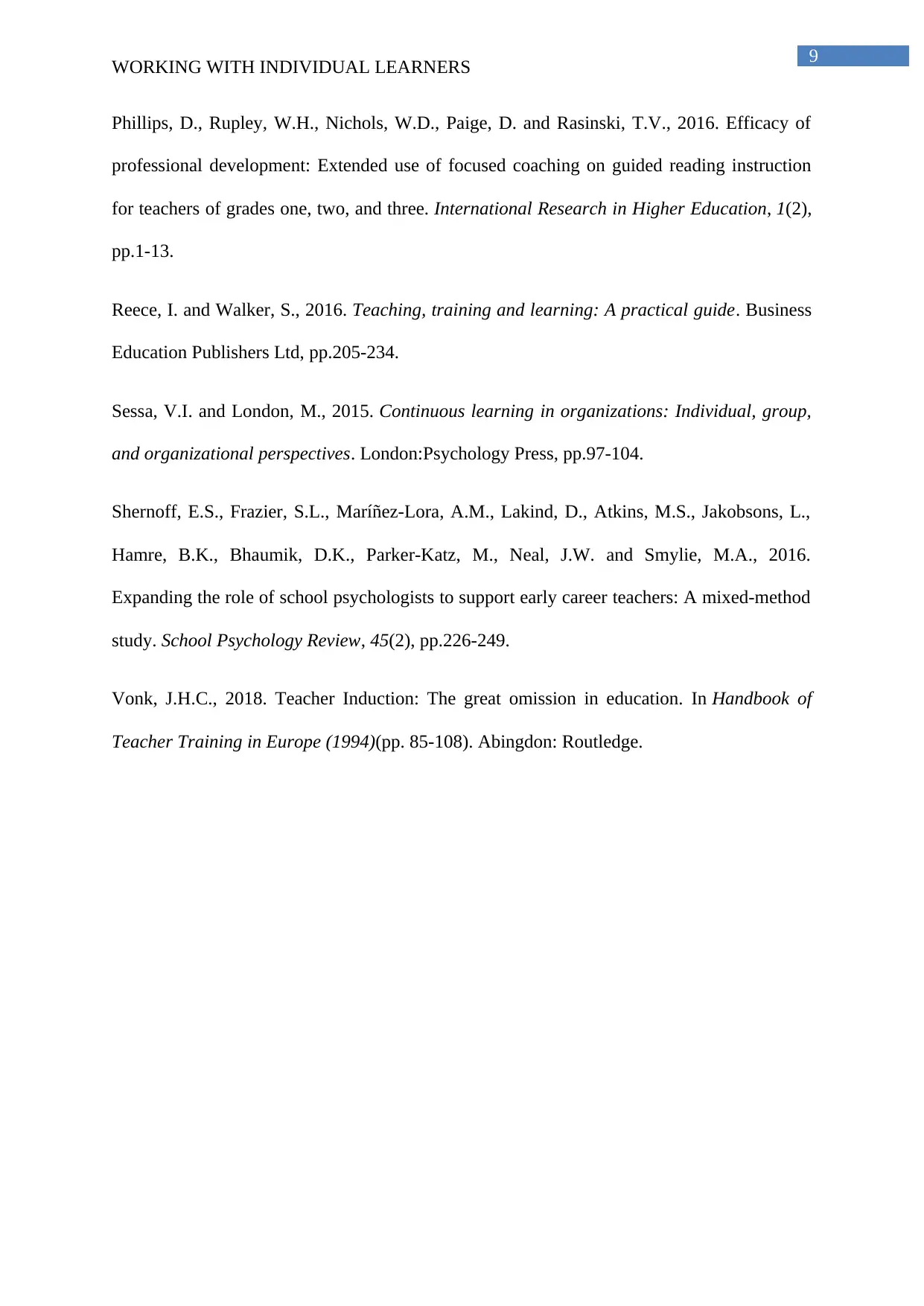
9
WORKING WITH INDIVIDUAL LEARNERS
Phillips, D., Rupley, W.H., Nichols, W.D., Paige, D. and Rasinski, T.V., 2016. Efficacy of
professional development: Extended use of focused coaching on guided reading instruction
for teachers of grades one, two, and three. International Research in Higher Education, 1(2),
pp.1-13.
Reece, I. and Walker, S., 2016. Teaching, training and learning: A practical guide. Business
Education Publishers Ltd, pp.205-234.
Sessa, V.I. and London, M., 2015. Continuous learning in organizations: Individual, group,
and organizational perspectives. London:Psychology Press, pp.97-104.
Shernoff, E.S., Frazier, S.L., Maríñez-Lora, A.M., Lakind, D., Atkins, M.S., Jakobsons, L.,
Hamre, B.K., Bhaumik, D.K., Parker-Katz, M., Neal, J.W. and Smylie, M.A., 2016.
Expanding the role of school psychologists to support early career teachers: A mixed-method
study. School Psychology Review, 45(2), pp.226-249.
Vonk, J.H.C., 2018. Teacher Induction: The great omission in education. In Handbook of
Teacher Training in Europe (1994)(pp. 85-108). Abingdon: Routledge.
WORKING WITH INDIVIDUAL LEARNERS
Phillips, D., Rupley, W.H., Nichols, W.D., Paige, D. and Rasinski, T.V., 2016. Efficacy of
professional development: Extended use of focused coaching on guided reading instruction
for teachers of grades one, two, and three. International Research in Higher Education, 1(2),
pp.1-13.
Reece, I. and Walker, S., 2016. Teaching, training and learning: A practical guide. Business
Education Publishers Ltd, pp.205-234.
Sessa, V.I. and London, M., 2015. Continuous learning in organizations: Individual, group,
and organizational perspectives. London:Psychology Press, pp.97-104.
Shernoff, E.S., Frazier, S.L., Maríñez-Lora, A.M., Lakind, D., Atkins, M.S., Jakobsons, L.,
Hamre, B.K., Bhaumik, D.K., Parker-Katz, M., Neal, J.W. and Smylie, M.A., 2016.
Expanding the role of school psychologists to support early career teachers: A mixed-method
study. School Psychology Review, 45(2), pp.226-249.
Vonk, J.H.C., 2018. Teacher Induction: The great omission in education. In Handbook of
Teacher Training in Europe (1994)(pp. 85-108). Abingdon: Routledge.
1 out of 10
Related Documents
Your All-in-One AI-Powered Toolkit for Academic Success.
+13062052269
info@desklib.com
Available 24*7 on WhatsApp / Email
![[object Object]](/_next/static/media/star-bottom.7253800d.svg)
Unlock your academic potential
Copyright © 2020–2025 A2Z Services. All Rights Reserved. Developed and managed by ZUCOL.




